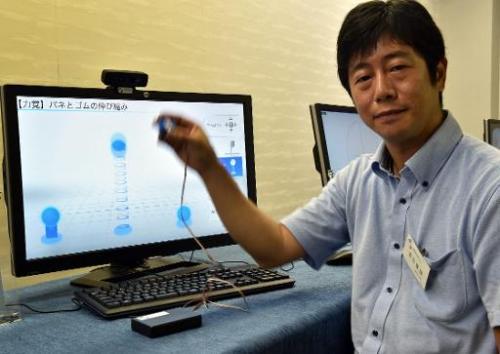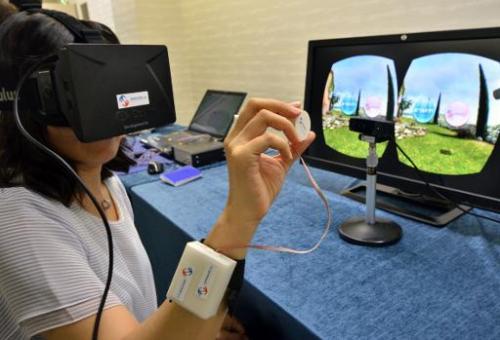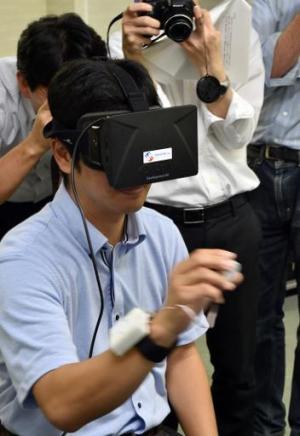Japanese Tech Firm, Miraisens, Unveils New “Touchable” 3D Technology Which May Influence 3D Printing
Japanese high-tech firm, Miraisens, announced that it has developed haptic technology, which closes the tactility gap that formerly existed with the virtual reality experience. Haptic technology or “haptics” simulates the sense of touch by applying vibrations, forces, or motions to the user. The company, based in Tsukuba, just outside of Tokyo, says its haptic technology “will give you a sense that you can touch objects in the 3D world.”

Japan’s high-tech venture Miraisens CEO Natsuo Koda demonstrates “3D-Haptics Technology” at a press preview.
More familiar applications for haptic technology are, for example, the video game controllers that simulate the tactile experience of automobile driving–from racing to high-speed chases. Game controllers, including steering wheels, rumble or vibrate in response to, for instance, the texture of the road surface, the speed of the vehicle. and certain driving maneuvers such as sharp turns. Miraisens’ haptic technology renders earlier efforts like these somewhat quaint. “It works by fooling the brain,” says Norio Nakamura, chief technical officer at Miraisens, and the inventer of 3D-Haptics Technology, “blending the images the eye is seeing with different patterns of vibration created by a small device on the fingertip.”
At the press conference in Tsukuba, a journalist was allowed to demonstrate a prototype head-mount display, which connects with a small hand-held, coin-shaped device that enables the user to feel resistance from virtual buttons he or she pushes. The company says the haptics system can be built into devices in the shape of pens, sticks, or coins, like the one demonstrated. In fact, as a company spokesperson suggested, one particularly invaluable use for the new technology a navigation assistance system in the form of a cane for visually impaired people.
Miraisens, which is a spin-off of the National Institute of Advanced Industrial Science and Technology, anticipates many uses for the technology, including opening remarkable new 3D horizons in video gaming: “It could be used to give a sense of resistance in response to certain actions within the game,” they speculated. Other likely uses will be medicine or a combination of medicine and robotics, particularly with remote surgery. In such scenarios, an expert surgeon might perform surgery on a patient from a thousand miles away. Nursing staff would set up the equipment, prep and monitor the patient. The surgeon would be a telepresence, receiving resistance and tactile feedback during the procedure.
The company provided other examples where their haptics system could be applied and this is where 3D printing comes into play: “It could also be used,” they suggest, “to make up complicated data that could be fed into a 3D printer, allowing a child to make a virtual dinosaur model and then watch it come into existence.” And that’s evidently the next step for Miraisens, as the company aims to create commercial applications for this groundbreaking technology in the electronics and service industries.
What do you think would be the best uses for this technology within the 3D printing and modeling space? Discuss in the Touchable 3D Technology forum thread on 3DPB.com
Subscribe to Our Email Newsletter
Stay up-to-date on all the latest news from the 3D printing industry and receive information and offers from third party vendors.
You May Also Like
Precision at the Microscale: UK Researchers Advance Medical Devices with BMF’s 3D Printing Tech
University of Nottingham researchers are using Boston Micro Fabrication‘s (BMF) 3D printing technology to develop medical devices that improve compatibility with human tissue. Funded by a UK grant, this project...
3D Printing Webinar and Event Roundup: April 21, 2024
It’s another busy week of webinars and events, starting with Hannover Messe in Germany and continuing with Metalcasting Congress, Chinaplas, TechBlick’s Innovation Festival, and more. Stratasys continues its advanced training...
3D Printing Webinar and Event Roundup: March 17, 2024
It’s another busy week of webinars and events, including SALMED 2024 and AM Forum in Berlin. Stratasys continues its in-person training and is offering two webinars, ASTM is holding a...
3D Printed Micro Antenna is 15% Smaller and 6X Lighter
Horizon Microtechnologies has achieved success in creating a high-frequency D-Band horn antenna through micro 3D printing. However, this achievement did not rely solely on 3D printing; it involved a combination...































